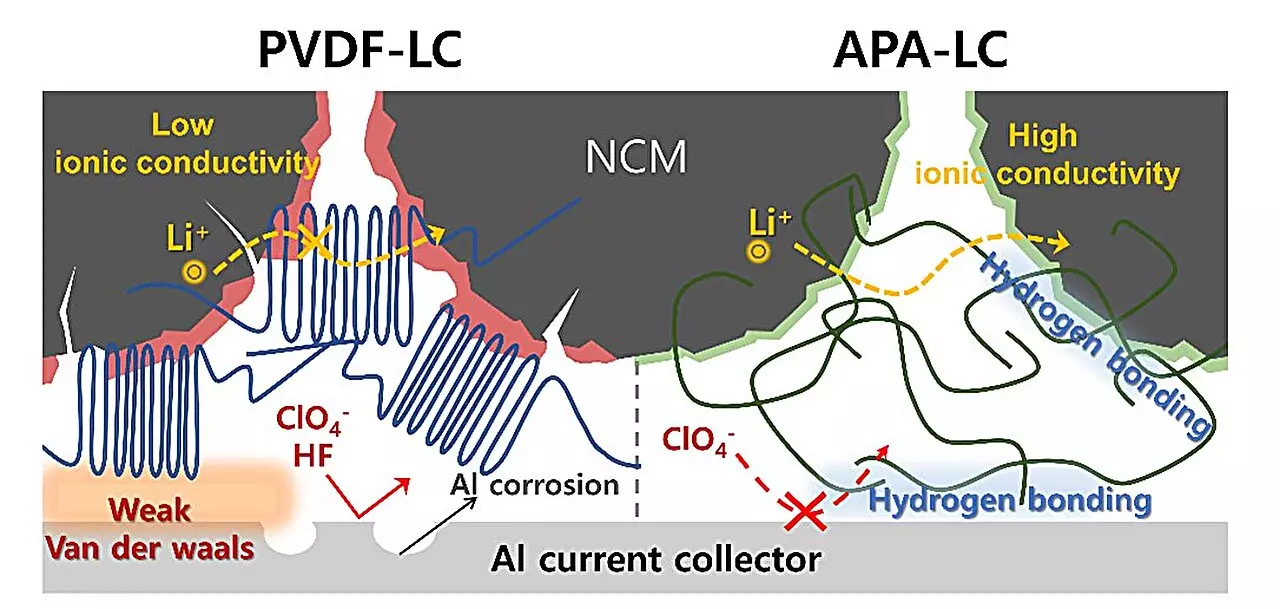The advancement of technology often goes hand in hand with environmental responsibility. With the growing recognition of climate change and ecological degradation, there is an urgent need for sustainable materials, especially in energy storage technologies like batteries. Traditional lithium-ion batteries predominantly utilize fluorinated compounds such as polyvinylidene fluoride (PVDF) for binders and lithium hexafluorophosphate (LiPF6) for electrolytes. While these materials have served their purpose well, they come with significant downsides, including toxicity, regulatory concerns, and environmental persistence. As stricter regulations emerge, such as the anticipated ban on per- and polyfluoroalkyl substances (PFAS) in the European Union by 2026, the push for non-toxic and biodegradable alternatives has never been more crucial.
In response to these pressing environmental challenges, an innovative research team from Pohang University of Science and Technology (POSTECH) and Hansol Chemical has made significant strides in developing a fluorine-free battery system. Their research, recently detailed in the Chemical Engineering Journal, centers on a new, eco-friendly binder and electrolyte that presents a viable alternative to the conventional PFAS-laden systems. The proposed lithium perchlorate (LiClO4) electrolyte replaces traditional fluorinated electrolytes, and a novel non-fluorinated aromatic polyamide (APA) binder enhances the performance and sustainability of batteries.
This paradigm shift not only aligns with regulatory developments but also optimizes battery performance. By utilizing an APA binder, researchers strengthen the bond between the active materials of the cathode and the aluminum collector, effectively thwarting electrode corrosion. This innovation contributes to extending battery lifespan, a crucial factor in both consumer satisfaction and market viability.
Performance metrics reveal that the new APA-LC system offers distinct advantages over traditional models. The system demonstrates superior oxidation stability and maintains an impressive 20% higher capacity retention after 200 cycles, even under rigorous charging and discharging conditions. These tests, conducted within a voltage range of 2.8 to 4.3 V in a coin cell configuration, signify a leap forward in lithium-ion technology. This notable performance enhancement highlights how eco-friendly materials can meet and even surpass the capabilities of their fluorinated counterparts.
An exciting aspect of this development is the successful creation of a high-capacity 1.5 Ah pouch cell utilizing the proposed system. This pouch cell not only upholds strong discharge capacity but also exhibits outstanding results during fast-charging trials, indicating that high-performance and sustainable materials can indeed coexist.
The implications of this breakthrough extend far beyond academic interest. As Professor Soojin Park from POSTECH asserts, the research represents more than just a mere replacement of harmful fluorinated compounds; it establishes a foundation for sustainable battery systems. This development positions the industry for a transformative shift, moving towards materials that comply with environmental regulations while delivering high performance.
Additionally, the global market for cathode materials is anticipated to reach approximately KRW 1.7 trillion by 2026. Managing Director Young-Ho Yoon of Hansol Chemical underscores that by addressing concerns surrounding PFAS, the company aligns itself strategically within this burgeoning market. Continued investment in research and development will potentially reinforce their position as leading suppliers of environmentally friendly secondary battery materials.
The collaborative work between POSTECH and Hansol Chemical signals a significant turning point in battery technology, focusing on sustainable, fluorine-free alternatives that meet both performance and environmental standards. As the demand for greener technology escalates, innovations like the APA-LC system pave the way for a future where batteries contribute positively to our planet. As research continues and these technologies become mainstream, it is hoped that the approach of creating high-performance products without sacrificing ecological integrity will set a precedent for other industries to follow. The ongoing journey toward sustainable energy storage represents not only a challenge but an extraordinary opportunity for innovation and responsible environmental stewardship.

